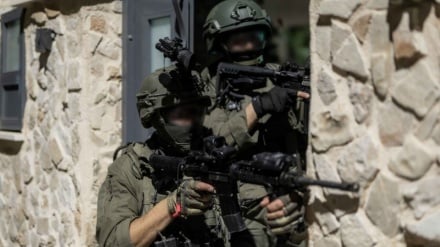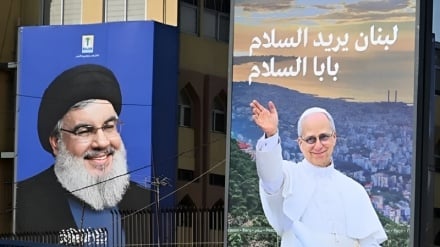How will resistance front expand?
-

How will resistance front expand?
Pars Today- Due to a type of strongly software living, resistance is related to quality more than anything else. The spectacular performance of the Lebanese resistance, which is mainly based in small regions of the south of the country, demonstrates this issue clearly.
Imam Khamenei, the Leader of the Islamic Revolution, addressing a group of the Iranian people from all walks of life on Wednesday (December 11), explained the stances of the Islamic Republic of Iran and resistance towards the regional and Syrian developments. According to Pars Today, quoting from daily Farhikhtegan, Seyyed Mehdi Talebi, a researcher of international issues, in an opinion titled, "Resistance Front Thinking of Strategic Counterattack", has touched upon one of the most important issues raised by the Leader among the visiting people, namely, the expansion of resistance front. We have chosen excerpts of his opinion:
To understand closely how resistance expands, various aspects should be taken into consideration. These aspects have been reviewed here.
- Production and re-production of resistance
Resistance in West Asia is related to the Western hegemony and occupation by Zionist regime. As long as these phenomena exist, the region is the place of zealous movements and formation of resistance views. Naturally, with the blossoming and formation of resistance groups, these groups move upward in the hierarchy of power and become coordinated with each other in similar views.
The occurrence of the Islamic Revolution in Iran aimed at liberating the country from the American hegemony and the ensuing aid of Tehran to shape resistance in Lebanon, Iraq and Yemen clearly shows this course. In addition to production of resistance in the region due to the actions of the West and the Zionist regime, continuation of their destructive policies can lead to re-production of resistance, too.
For instance, the Sudanese government used to cooperate with the resistance front for long and played a significant role in arming it. Later on, however, it decided to compromise with the West. The result of this compromise was the downfall of the government of General Omar al-Bashir and the continuation of sanctions and economic crisis for the next government. The West and its allies had promised Omar al-Bashir that if he cooperated with them, his government would get rid of pressures, but the continuation of pressures caused his downfall. On the other hand, the next government, too, had no share of the cake in spite of further promises of the West. The Western measures against Sudan went to the extent that, despite the military system's promise to establish relations with the Zionist regime, they (Westerners) tried to seize Khartoum and overthrow the political system through the paramilitary fighters affiliated to "Mohamed Hamdan Dagalo", Head of the Rapid Support Forces (RSF). The blows that the Sudanese received from the West and Zionism caused them to move once again towards resistance and the resistance front despite abandoning both of them before. They first returned to their resistance stance and then improved their relations gradually with Iran.
- General and specific meaning of resistance and process of strengthening
Resistance has a general and a specific meaning. All nations in the region loathe the Zionist regime and some of them, although they live under dictatorial regimes, have forced their governments to be pretentiously heedful in dealing with the Zionist regime. The hard course of normalization of ties with the fake regime for Islamic and Arab governments and, also, restriction of their ties, even in the case of having political relations with Tel Aviv, is a sign of the effect of nations. As for the specific meaning, however, it is the resistance groups which go beyond mass activities and, in a structural form in different domains, are active round-the-clock against hegemony in a targeted way. Resistance groups and governments, too, have flourished from resistant nations.
The Iraqi government at the time of the Ba'athist party and the government of "Saddam" was active against the Islamic Republic of Iran. The next phase was the occupation of the country by the US. Yet, these phases resulted in molding of resistance groups from the Iraqi nation. The situation was the same in Yemen, too. The Yemeni government stood by Saddam during the imposed war and sent soldiers to fight against Iran. The government of "Ali Abdullah Saleh", the dictator in the country, would suppress Islamists and Zaidi Shias, but he, too, was isolated under the pressure of resistance views of the Yemeni nation and formation of Ansarullah resistance group. Depending on their potentials, nations are in the process of turning the general resistance to the specific one.
- Initial arraying and seeking help
The expansion of resistance is not restricted to geographical growth; but it can rather take place even in a geographical boundary where resistance is strongly active. To realize this, clear examples should be reviewed. Resistance against the Zionist regime was limited to Shias in Lebanon for long. Sunni groups, deceived by the Persian Gulf littoral states, would refuse to even adopt stances against the Zionist regime. Sunni Islamist groups, like Ikhwan al-Muslimeen, too, had failed to show an activity due to the wealth and influence of political groups affiliated to Arab government. Meanwhile, Christians in Lebanon, with a number of their paramilitary groups, showed a much worse performance than Sunnis and used to help Tel Aviv to continue occupation of their soil. Nevertheless, in addition to Shias, Sunnis and Christians, too, are gradually joining practical struggle against the Zionist regime. Sunni Muslims, particularly through Jamaat Islami (the branch of Ikhwan al-Muslimeen in the country) have fought alongside resistance during the al-Aqsa Storm war and offered many martyrs to the cause of al-Qods. Moreover, Christians have adopted stances against the Israeli occupation and some of them have joined political alliance with resistance. It looks likely that Christians will also take military and armed measures against the occupation by Tel Aviv.
- Qualitative expansion
Due to a type of strongly software living, resistance is related to quality more than anything else. The spectacular performance of the Lebanese resistance, which is mainly based in small regions of the south of the country, demonstrates this issue clearly. Small population, little area, long distance from the center of resistance, being sieged among foreign and domestic enemies, and relatively limited facilities compared with what enemies enjoy, have been among the difficulties of the Lebanese resistance. But, this group has grown constantly. Furthermore, although the Shias in Afghanistan and Pakistan were weak, resistance groups, which were shaped among them in these two countries, played an effective role in suppressing Takfiri terrorists. Strengthening resistance views among Sunni communities who support resistance, increasing their activities and all-out bolstering of their media, economy and military, is part of the expansion of resistance. Once, the Lebanese resistance was alone in the south of the country, but the group's gradual going from strength to strength and strengthening it by Iran spread its effectiveness to a notable scope to play role in the events of other regions from Bosnia to Syria and Iraq.
Through bolstering of resistance views and equipment, Shias of Afghanistan and Pakistan, too, succeeded to a play role in the regional developments. The communities supporting resistance have joined the resistance views for decades. But, in every period, they grow in a way that their previous state looks low and weak in comparison with their new one.
- Keeping geography and annexation of new geography
Resistance in the face of the US and the Zionist regime has annexed a new geography in every phase. In 1979, Iranian Muslim revolutionaries succeeded to overthrow the US mercenary regime in the country. After a while, with the invasion of Lebanon by the Zionist regime in 1982, the Lebanese resistance was shaped. During the Takfiri conspiracy against Syria, which started in 2011, resistance views gradually grew among the Shias, Sunnis and Christians of this country. Formation of the Syrian popular mobilization was [the outcome of] organizing and upgrading these views. Popular combat groups, which had been formed to preserve local Syrian communities against terrorists, were officially recognized and coordinated in this structure. In 2014, when Ansarullah movement reached the capital Sanaa, the Yemeni government joined the resistance governments, too, and in other words, it turned into the second totally resistance government in the region after Tehran. This is while the resistance groups in Iraq and Lebanon have just managed to have a share in the government, whereas the political system, as a whole, does not have such an approach. Resistance has not lost any geographical part in the regions where it has been originally active. Sudan and Syria, which have exited the resistance circle due to change of policies or downfall, were governments which cooperated with resistance. But, in Lebanon, Yemen, Iraq and Iran, resistance had not withdrawn from its geography. Due to the current developments, the axis of resistance will probably affect a new geography.
Key phrases: axis of resistance, Islamic Revolution of Iran and resistance front, Lebanese Hezbollah, Yemen
RM/ME


